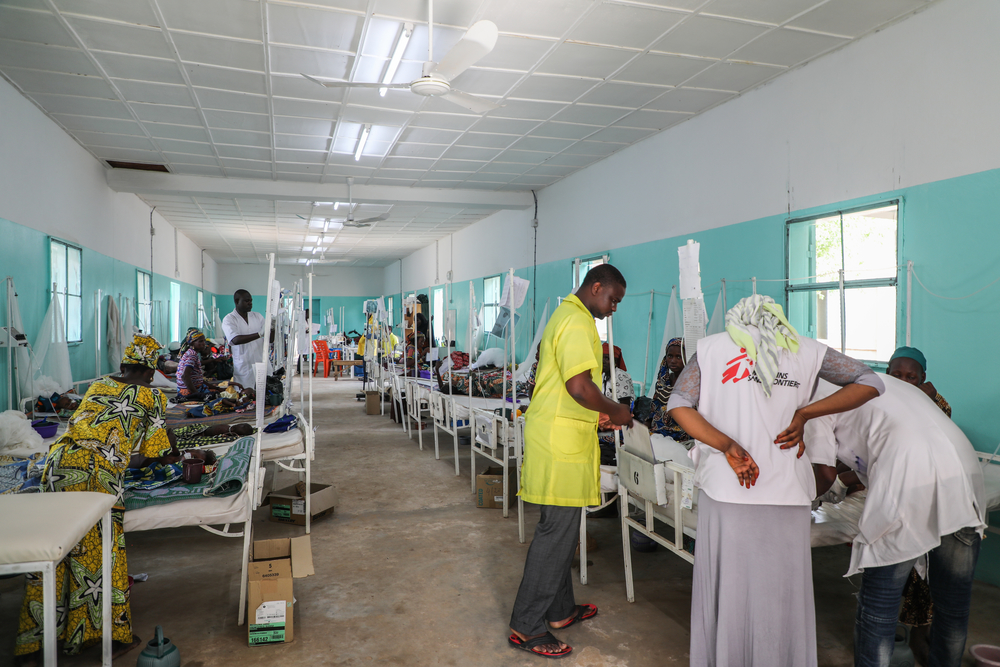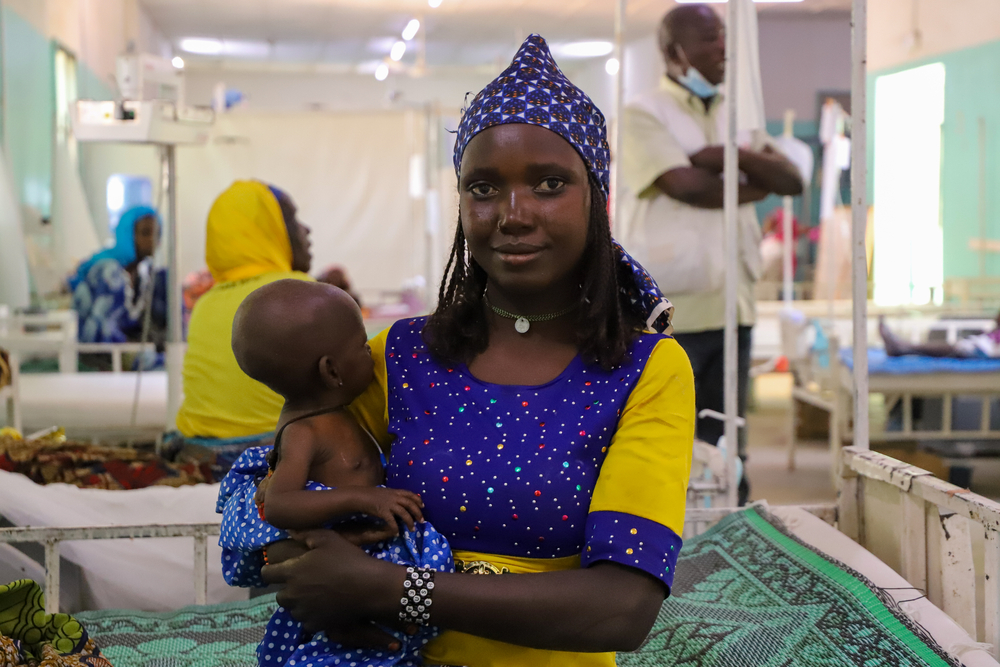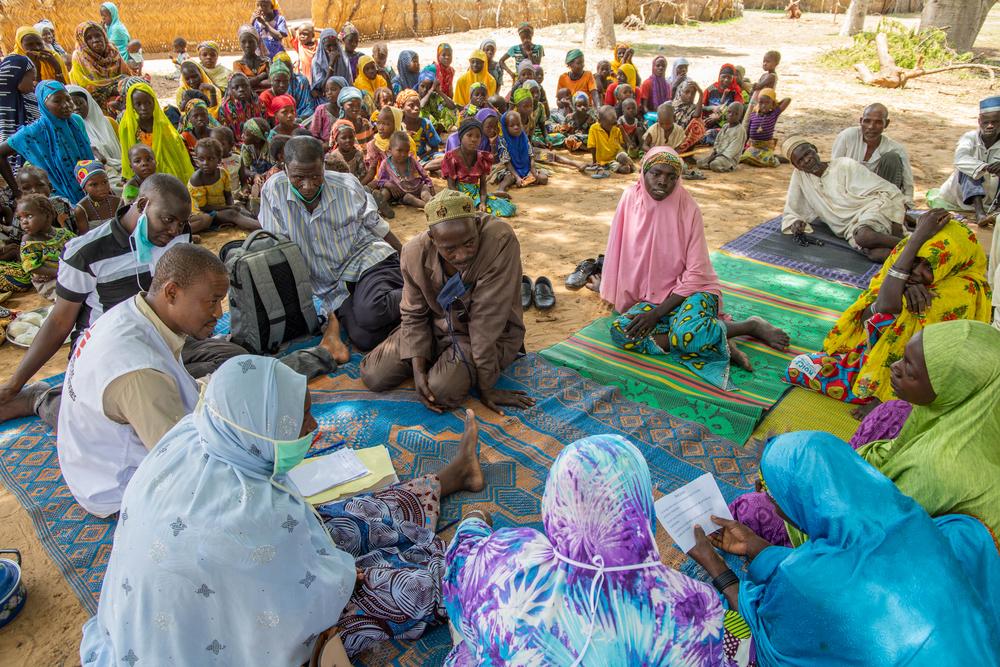In September 2018, nurse Awa Abou Amadou was working at the Médecins Sans Frontières (MSF) paediatric unit in Magaria in southern Niger. It was her most challenging experience as a nurse. “We used to admit around 140 children a day. It wasn’t easy,” she says. Among other nurses and medical personnel, she worked for long hours straight – sometimes from dusk till dawn and beyond.
“How do you expect me to leave the hospital at the end of my shift if I could save another baby’s life?” she says. “When we would leave at night to go back to our families, our minds and thoughts were still with the kids at the hospital.”
Indeed, during that period, around 850 children were admitted and hospitalised at the paediatric unit each week, the vast majority for malaria and malnutrition. It was the busiest period that the hospital has ever seen, making it the biggest paediatric unit for malnutrition and malaria of this type in the world with more than 600 staff working around the clock. In comparison, the unit’s original capacity was 200 beds.
While our hospital was already terribly overwhelmed even with additional beds and staff, it was likely that some of the children who were seriously ill in the community were not getting the care they need.

“We always wondered what’s it like in the most remote communities, where people couldn’t afford to come to the hospital.” For MSF, 2018 was a turning point in the history of the project. This “heavy machine” was not easy to operate and something needed to be done about it.
In the following three years, the numbers remained high between September and October, which is the malaria and malnutrition peak season, but nothing compared to 2018. You might ask what has changed in the course of three years, and the answer is decentralised care, in alignment with Niger’s national strategy. It is also through other strategies and activities put in place such as the implementation of the seasonal malaria chemoprevention activity, the distributions of mosquito nets, water treatment and household spraying. These strategies combined, whether at the same time or intermittently, have helped to unburden the hospital, and as a result improve the quality of care.
Awa is not the only person who remembers 2018 as if it was yesterday. Zaharia Mahamadou, a mother of five, first came to the MSF’s paediatric unit in 2018, when her daughter Firdawsi had to stay for 32 days due severe malnutrition and high fever.
“I was worried Firdawsi would die, I saw many mothers losing their children at that time, whether at home or at the hospital,” says Zaharia. “The idea of losing Firdawsi terrorised me so much that I cried for several days non-stop, but I was always hopeful,” she says.
Today, Zaharia is at the hospital with her youngest daughter Balkisou. Since 2018, Zaharia has been coming every year with one of her children or more. “When I look back and remember Firdawsi’s situation in 2018 and then see her today running and playing like other kids, I regain my strength. I know that my other kids will get better, just like their sister did,” she says.

But before we dig deeper into the community approach that our teams are following in Magaria, let’s first get familiar with this part of Niger.
The district of Magaria is in southern Niger, close to the Nigerian border, almost 100 kilometres away from Zinder, Niger’s second largest city. Magaria is on the trading route between northern Nigeria, mainly the city of Kano, and Niger’s urban centres.
Home to more than 798,000 people and with a density of 216 habitants per square kilometre, the district of Magaria is rural and known to be rich in water and home to large agriculture fields. Around 21 per cent of people are under the age of five.
The district of Magaria has one hospital in which our teams help to run a paediatric unit, a further 76 health posts and 20 integrated health posts. Yet, according to the annual statistics from 2018, around 41.5 per cent of people don’t have regular access to healthcare.
We first intervened in Magaria in 2005, following a malnutrition crisis in southern Niger. Today, we are still present in Magaria and continue to run the paediatric unit at the district’s hospital, with 120 beds during the regular season. Our teams provide free medical care to children under five, mostly for malaria and malnutrition among other pathologies. With every rainy season that starts in June and ends in October, malaria rates in Magaria spike, especially among children under five, and hospital admissions increase accordingly.

The admission rates at our paediatric unit in 2018 were the highest they had been for six years, with 20,235 admissions compared to 14,849 admissions in 2017 and 15,344 admissions in 2019. The death rate in 2018 was also the highest it had been for six years, at 7.5 per cent. The mortality rate was also fuelled by the late arrival of children to the hospital.
After the 2018 peak, we started increasing our presence in nearby villages and towns, either by supporting local health centres, reinforcing observation and stabilisation rooms, or by increasing community work at the village-level.
The aim was clear: decrease the number of severe cases at the paediatric unit to avoid a scenario similar to 2018. The strategy has been managed through various activities with support from hundreds of medical, paramedical and logistics team members. We have also worked in collaboration with the Ministry of Public Health as the main responder in Zinder region.
1. Early detection and community treatment:
In April 2019, we began training 68 community members in 35 villages in the commune of Magaria as part of our ICCM strategy. The strategy trains and deploys community health workers in hard-to-reach areas to provide diagnostic, treatment and referral services for three common, treatable and curable childhood illnesses: malaria, pneumonia, and diarrhoea in children under five. The aim of these community activities is to facilitate access to basic healthcare and prevent the development of medical complications these children. This enables us to treat the children without the need to visit distant health centres, turn to traditional healers or use unlicensed drugs.
In June 2019, these activities expanded to the commune of Dan Tchiao in 34 new villages. In March 2020, we added 35 more villages in the commune of Sassoum Broum, and by September 2020, 53 new villages in the commune of Bandé.
By October 2021, more than two years after the first activities were launched, our teams are implementing this strategy in 165 villages in four communes, with a total of 278 community health workers.
The decentralised care strategy works by sending mildly sick children home with medication and referring the most severely sick children to health centres. Our teams there can stabilise young patients or keep them under observation for a few days. If necessary, they are transferred to the referral paediatric unit in Magaria for treatment.
Throughout the years, the number of consultations given at community levels has increased, from 45,045 in 2019, to 115,215 in 2020 and 113,652 until the end of October 2021. By this date, our teams have given 57,617 consultations for malaria, 22,623 consultations for diarrhoea, 24,131 consultations for pneumonia and 4,768 consultations for the common cold and cough. This demonstrates a great need for medical treatment at the community level, a need that the community health workers can meet with the necessary supervision and medical supplies. It is difficult to have an exact number, but early treatment would certainly have saved the lives of many children.
Read more on MSF’s ICCM activities in Magaria
2. Cutting the malaria chain of transmission:
In addition to doing community outreach, we also focused on prevention activities. In June 2021, our teams launched a pilot activity in 15 villages in the commune of Bandé to prevent the development of mosquito larvae that spread malaria. These villages have large quantities of water, very close to people’s homes. These water points have become a breeding ground and habitat for different types of mosquito, including anopheles, which are responsible for the transmission of malaria throughout the year. With every rainy season, the water surface increases by three or four times, creating more opportunity for egg-laying and larvae development.
The villages were selected based on the available medical data on malaria cases per village from previous years.
Read more on MSF’s water treatment activities in Magaria
Our teams have launched a second activity in nine villages in Maidamoussa, in the commune of Magaria, to attack malaria by spraying the inside of houses.
The activity consists of spraying the walls of houses and mosques with insecticides, to cut the chain of transmission of the disease. The malaria rate from these nine villages has been high in the past years, especially during the rainy season.
3. Community awareness and education:
Another essential element that we have put in place is increased community education; the education carried out by MSF health promoters and awareness-raising done by community agents, also known as “Mamans Lumière”, or “mothers of light”.
The Mamans Lumière project consists of training and supporting mothers from different villages to raise awareness and educate their fellow villagers about malaria and malnutrition, and to help detect cases as early as possible, before they worsen and require hospital care.
Not only do these trained mothers educate on the prevention of malaria, but they play a very important role in the fight against malnutrition. In difficult times, especially during the dry season, these women help others with food preparation that is nutritious and beneficial for children. They are also trained in using the mid-upper arm circumference measure tool, also known as MUAC. It is a long strip with a series of colour bands to indicate the severity of malnutrition.
Similar to the ICCM activity, the Mamans Lumière project started in 2019, and has gradually grown to include more villages. By October 2021, 181 Mamans Lumière were working around the clock in 165 villages.
Towards a holistic approach
With all the efforts being carried out at community level, fewer admissions of critical patients are being recorded at the Magaria paediatric unit, and in parallel, more consultations are being done at community level and earlier stages of illness.
These solutions have shown effectiveness after more than two years of implementation, but the road hasn’t always been easy. Regular follow-up, close monitoring and constant support is required every step of the way. But most importantly, the community’s engagement and motivation, and the acceptance of new approaches have been vital for such success, all of which isn’t always easy or guaranteed.
The focus on community approach cannot work on its own: a referral system and a good hospital are needed to ensure continuity of care and full access to healthcare in severe cases: this is a holistic project at all levels.
Today, as the sole international actor in the region around Magaria, MSF has had to shift activities from emergency medical response, to capacity-building and prevention-orientated projects. The solution is not only medical, but is multifactorial.
In order to truly break the cycle of child malnutrition and malaria in a sustainable way, comprehensive development programmes and the involvement of a range of actors specialised in food security and health promotion are required. Positive effects can already be seen at clinical level, but more needs to be done at all stages to improve the children’s health and development.
